CrystalMaker 11 in action: Clockwise from top left: Animation Frames; Porosity Visualization; Twin Morphology in Albite; High-T Monte Carlo Simulation.
Introducing CrystalMaker 11

Runs Natively on
Apple Silicon
CrystalMaker is the most-efficient way to visualize crystal and molecular structures. Its interactive design lets you "see the wood for the trees" and build your own visual understanding of complex materials. CrystalMaker transcends traditional crystallography software, letting you create dynamical visualizations with rotatable animations. Energy-modelling tools let you design and relax new structures, predict their vibrational properties, and explore how they interface with other materials.
- Crystal-energy modelling
- Surface relaxation
- Phonons explorer
- IR spectra for crystals
- Simulate temperature & pressure
- Density of states
- Physical & thermodynamic properties
- Display of "close contacts"
- Supercharged "Packing Explorer"
- Angles Explorer Version 11.5
- Crystal Shapes Version 11.5
- Keywords
- Scale bar
- Grow tool Version 11.5
- Auto range
- Auto perspective
- Dynamic red/blue stereo
- AI-powered hand tracking (Mac)
- Streamlined interface
- Gallery window
- QuickLook plug-ins Version 11.5
- CrystalViewer structures libraries
- Global licensing engine
- Learn More...
Full Crystal-Energy Modelling
CrystalMaker 11 is the culmination of a 10-year research project, during which time we have sponsored a Ph.D. project and a Knowledge Transfer Partnership (KTP). The aim was to develop accessible energy modelling and lattice dynamics tools for personal computers. This builds on our long-term goal of providing the best visual understanding of complex structures and properties, bringing workstation-level tools to the wider scientific computer - without the need for energy-wasting supercomputers.

Relaxing a perovskite structure in CrystalMaker 11.
CrystalMaker 11 features its own, integrated crystal-energy modelling engine. At the core of this is a massive library of parameterised potentials. The program uses smart selection criteria, based on existing bonding criteria and detailed knowledge of atomic environments. Energy minimisation uses a novel hybrid Monte Carlo and least-squares technique, permitting real-time relaxation - including for surfaces.
- Force field approach, using parameterised potentials calibrated using DFT: all the advantages of DFT, but works in real time, with much larger systems - and on your laptop!
- Smart selection of potentials, based on bonding environment: requires no additional user input.
- Monte Carlo technique allows relaxation of structures far from equilibrium - e.g., crude, hand-drawn structures with excessive bond lengths and distorted bond angles!
- Hybrid least-squares cycle added to provide greater precision in the closing stages of refinement.
- Provides energy output, available in graphical form during the course of the refinement cycle, and later, via a menu command.
- Calculates vibrational modes, including vibrational frequencies for crystals (phonons) and molecules - the latter with simulated infra-red spectrum.
Phonons Explorer
CrystalMaker 11 can calculate vibrational modes for crystals, including dispersion curves and structural animations. Lattice waves, or "phonons", can be visualized for any point in reciprocal space. You can specify two points in reciprocal space and have the corresponding disperson curves shown; simply click on a point on a dispersion curve to define a wave vector and visualize its vibrational mode.

Visualizing an optical phonon mode in the halite structure.
Simulate Temperature & Pressure
The Simulate Temperature & Pressure command lets you simulate the effects of temperature and, optionally, pressure. CrystalMaker will run a Monte Carlo simulation using either constant volume ("NVT") or constant pressure ("NPT"), using the temperature/pressure you specify. The structure (ideally, a supercell) is updated in real time with energy values plotted.
As well as providing an interactive visualization of structural changes, this command provides a useful way of disordering an otherwise ideal material, e.g., to provide an "amorphous" structure for subsequent modelling calculations.

Monte Carlo simulation of halite at 1000 K .
Physical & Thermodynamic Properties
As part of its energy modelling, CrystalMaker can calculate the density of states for your crystal. This can be visualized as a histogram showing the relative population of different vibrational frequencies. The underlying calculations also underpin predictions of physical and thermodynamic properties:
- Zero-point energy
- Vibration energy
- Helmholtz free energy
- Entropy
- Specific heat capacity
- Elastic constants tensor
- Elastic modulii
- Acoustic velocities: transverse ("s waves") and longitudinal ("p waves").
- Young’s modulii
- Poisson’s Ratio
- Dielecctric tensor
- Refractive Indices
Molecular Modelling and Vibrational Modes
CrystalMake lets you turn crude, hand-drawn molecular structures into lowest-energy three-dimensional structures. Visualize the relaxation in real time - you can even rotate your model as it relaxes. Video.
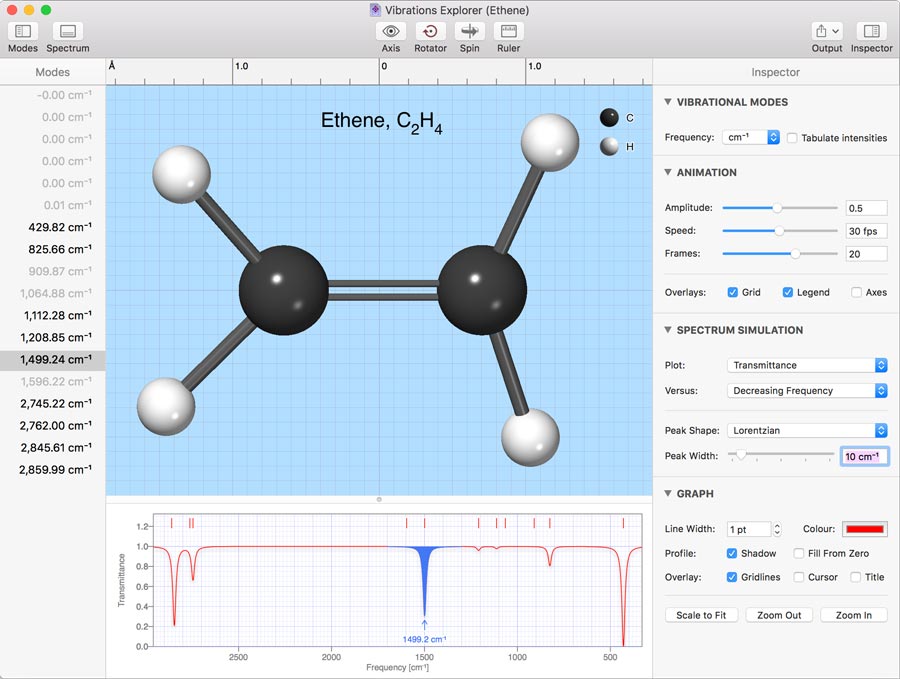
Visualizing vibrational modes in ethene. All the permitted modes (including 6 zero-frequency translational modes) are listed on the left. The selected mode is animated - with user adjustable amplitude, speed and quality (number of frames). Animating models can be rotated and scaled and viewed using different model types (e.g., switch to stick view or space-filling). The current mode is shown highlighted in the calculated infra-red spectrum at the bottom of the screen.
Molecular Crystal Tools
Our mantra of letting you "see the wood for the trees" is particularly apposite when working with complex molecular crystals. Often there's more to see than just the asymmetric unit - the packing for a start - and other programs struggle with fragmented molecules at the edges of the unit cell.
CrystalMaker's dedicated tools let you reveal the intact contents of one unit cell, isolate individual molecules or show the asymmetric unit. You can repair "fragmented" molecules, "grow" the plot range along an atom's nearest-neighbours, and make sense out of complexity Video.
You can also now display short non-bonded contacts ("close contacts") for any selected molecule in a molecular crystal. Simply select an atom in a molecule of interest and choose the Selection > Show Close Contacts command. Any close contacts are shown as secondary bonds between atoms in the selected molecule and neighbouring molecules.
Packing Explorer
CrystalMaker 11 is the ultimate tool for designing new crystal structures. An all-new Packing Explorer lets you convert a molecule into a crystal, with full control over symmetry, cell parameters, molecular orientation and positionning - and with the option of real-time display of close contacts.
A new Tool Strip provides tools for real-time rotation, positioning, measurement and scaling. A new inspector features animated disclosure groups with live updates on packing efficiency and density.

Using the Packing Explorer to pack a molecule into a crystal. The space group is set to P 1, the molecule is rotated and moved, before final adjustment of the unit cell parameters. Close-contact distances are shown for the centre-most molecule in the resulting crystal.
Probe Atomic Environments
CrystalMaker provides easy-to-use screen tools for measuring coordination environments - bond distances, angles, torsion angles - just by clicking with the mouse, or rolling over different atoms and bonds for real-time output Video. You can also visualize coordination clusters and shells - with real-time radius adjustment, e.g., build a spherical nanoparticle with a single mouse click Video.
Detailed bond distance and angle information is available on screen, or can be exported to a text file. The powerful Distance Explorer lets you visualize coordination environments graphically, around any combination of elements or sites, visualizing distances Video and angular distributions Video.
You can also visualize x-ray or neutron Pair Distribution Functions, with the option of seeing "partial" pair distribution functions for selected element pairs Video.

Distance Explorer showing the distance density around silicon atoms in amorphous silica.
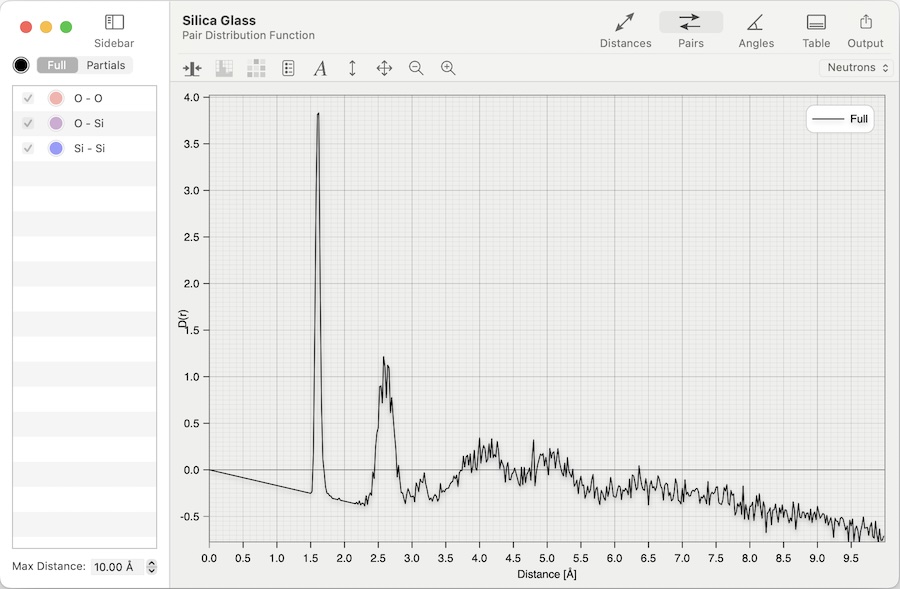
Calculated neutron Pair Distribution Function for amorphous silica.
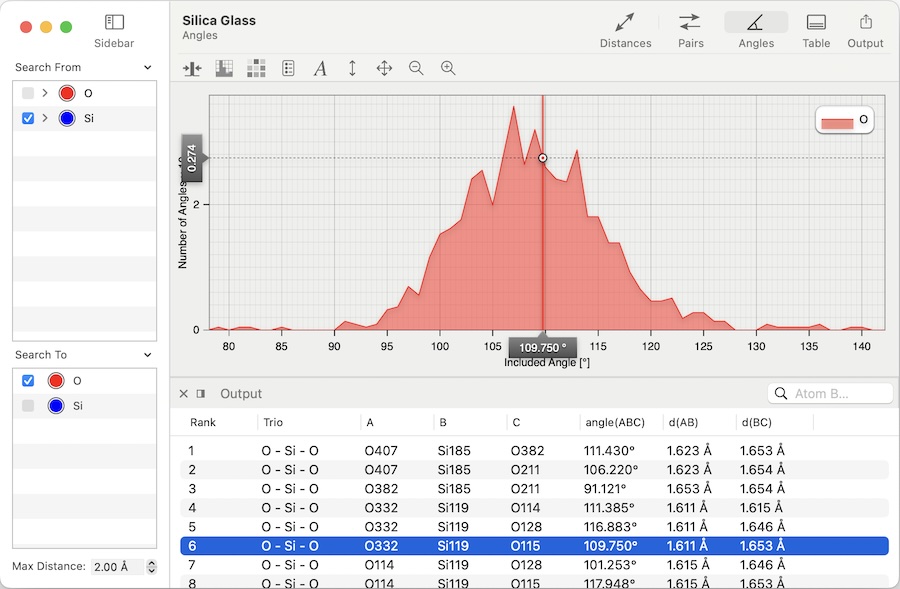
Angles Explorer showing the distribution of O--Si--O bond angles in amorphous silica.
Transformation & Crystal Engineering
CrystalMaker lets you transform the unit cell, changing the lattice type, building a supercell, moving the origin, or applying an arbitrary matrix transformation. You can also project the unit cell onto a chosen lattice plane, to create a "surface cell". Unlike traditional software, CrystalMaker features an elegant, easy-to-use interface, with common choices available as presets. Crystallography without the pain!
CrystalMaker's selection tools let you move, detach, duplicate, hide, delete groups of atoms. Hide or repair molecular fragments - isolate individual molecules. Display lattice planes in any orientation; slice the crystal to investigate surfaces or internal planes - and place one structure or molecule inside another. CrystalMaker's real-time crystal engineering tools let you insert space within your crystal lattice, place new atoms or entire molecules in the crystal - and design new crystal lattices Video.
- Plot Range: real-time control over atom range along xyz
- Spherical Cluster: real-time control over inner & outer radii of your "nanocrystal".
- Cavity Finder: automatically show the largest cavities in your structure using appropriately-sized translucent spheres.
- Selection Tools (arrow/rectangle, lasso, polygon, zapper) to hide or isolate groups within the structure.
- Slice lattice with oriented lattice plane: display surface.
- Slab generation: using two oriented lattice planes.
- Surface Cell Generation: projected onto a specified plane.
- Supercell: specify a multiple of the existing cell dimensions.
- General Matrix Transformation with presets (e.g., convert rhombohedral to hexagonal.)
- Discard Symmetry command; adds new sites to preserve your structure.
- Crystal-to-Molecule conversion.
- Packing Explorer provides interactive molecule-to-crystal command with live symmetry, cell parameters, position and orientation.
- Move or Rotate Groups of atoms within the crystal lattice.
- Duplicate Selected Atoms.
- Change Atom Types (element symbol, occupancy), using the Selection Inspector.
- Insert Space along a specified lattice plane within the crystal.
- Bend Lattice: select atoms, specify a radius of curvature and you have an instant nanotube (or bent sheet).
- Interpolate Structures: add intermediate structures to make animations of structural behaviour smoother.
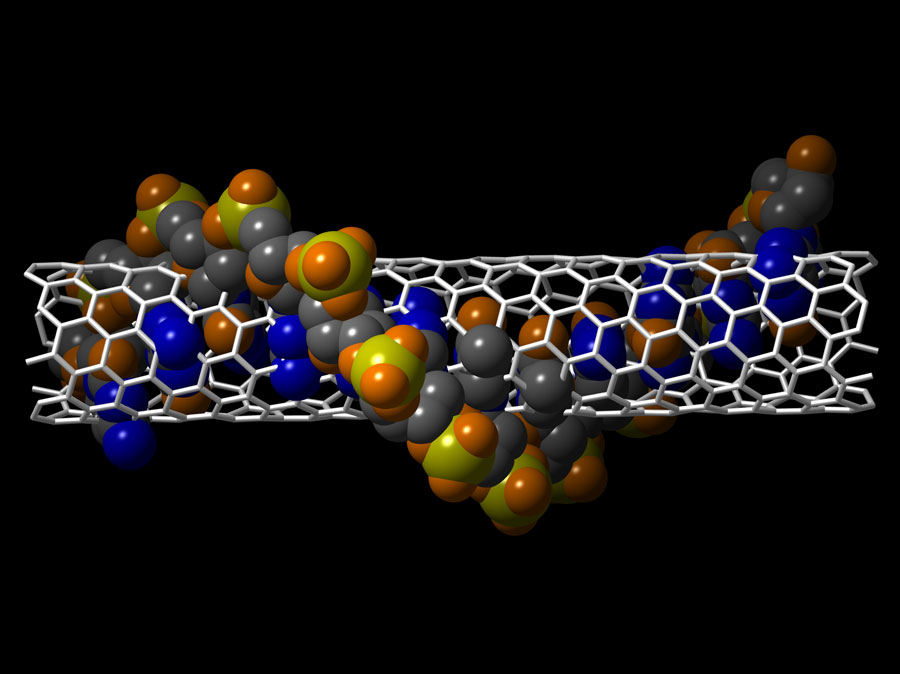
Left: Interface between two silicon crystals: a 111 domain and a 110 domain. Right: Combining two dissimilar structures in the same window to compare their scales. (Click to zoom)
Crystal Shapes
Easily create crystal shapes, with automatic addition of symmetry-related faces and real-time adjustment of distances (and hence face sizes). In "Shape Mode" you can hide all atoms and colourise your faces - with the option of revealing atoms inside the shape, and excluding them outside. You can also combine multiple shapes, so as to visualize chiral relationships such as left- and right-handed quartz, or twin laws. Video

CrystalMaker interface with Left- and right-handed quartz and the Planes Inspector at right (showing symmetry-related planes and their distances).

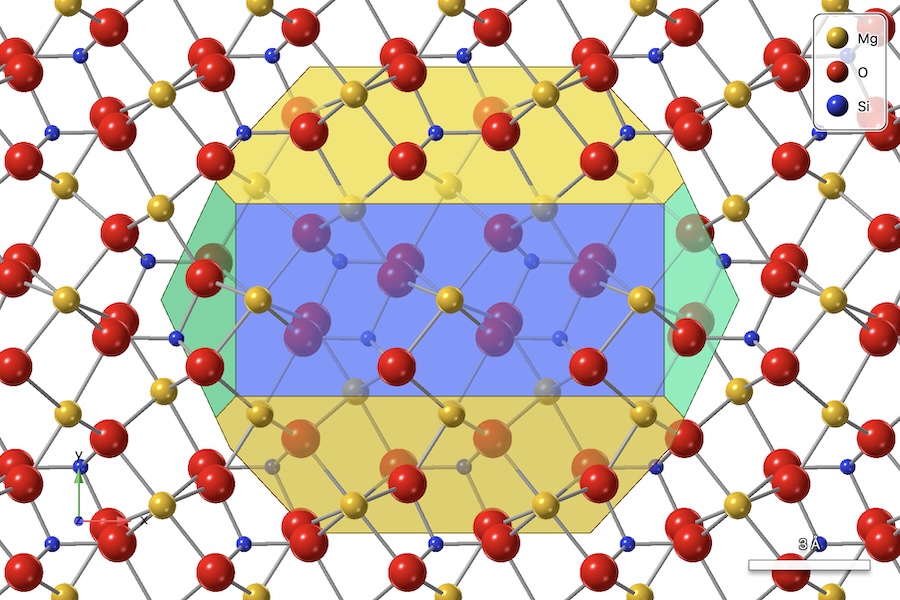
Left: Pyrope garnet: shape and structure. Right: Crystal structure of forsterite, with its macroscopic shape for reference. (Click to zoom)
Comprehensive Data Import & Export
CrystalMaker lets you import data from some 45 different formats: with instant display and powerful customization. CrystalMaker can handle including multi-structure files such as DL_POLY HISTORY - use CrystalMaker's synchronization and animation capabilities to rapidly understand structural behaviour, lattice dynamics, or visualize the trajectory of a simulation. CrystalMaker can also handle truly massive structures. Take advantage of our unique "Depth Profiling" tool, to rapidly scan ares of interest in massive structures - ideal for characterizing the results from computer models.
- 3ED Volumetric
- ATOMS (v4, v5)
- CASTEP Cell
- CASTEP Output
- CASTEP Volumetric
- CCL
- Chem3D Cartesian
- CIF
- CMDX (CrystalMaker X Document)
- CMDF (CrystalMaker 7–9 Crystal)
- CMMF (CrystalMaker 7–9 Molecule)
- CMTX (CrystalMaker Text)
- CSSR
- Gaussian CUBE
- DEN (Volumetric)
- DL_POLY Config
- DL_POLY Revcon
- DL_POLY History
- DMol3 "CAR" file
- DMol3 "ARC" trajectory file
- FDAT (CCSD)
- GRD (Volumetric)
- GROMACS
- GSAS
- GULP
- ICSD
- LAMMPS dump
- Molfile
- PDB
- Prismatic
- RMCProfile
- SDFile
- SHELX
- STRUPLO
- SYSTRE
- TOPAS
- VASP Structure (POSCAR, CONTCAR)
- VASP Trajectory (XDATCAR)
- VASP Volumetric (CHG, CHGCAR, etc.)
- VESTA
- Voxel
- WIEN2k Structure
- XCrySDen Structure (XSF)
- XCrySDen Animation (AXSF)
- XYZ
A range of output options is available for sharing data with other programs, saving structural data, bond distances, coordination environments - or even building web pages with your data.
- CASTEP Cell
- Chem3D Cartesian
- CIF
- CMDX (CrystalMaker X Document)
- CMTX (CrystalMaker Text)
- Coordinates file
- Visible Coordination file
- Crystal Coordination file
- Distances & Angles
- DL_POLY Config
- DL_POLY Revcon
- DMol3 "CAR" file
- Elements file
- GRD volumetric
- HTML Structure
- PDB
- RMCProfile
- VASP Structure
- Vibrational frequences & eigenvectors
- Vibrational spectrum (IR)
- Voxel volumetric
- XYZ
Volumetric Data Visualization
CrystalMaker lets you combine any number of 3D datasets with the current structure, each with its own visual settings. You can visualize data imported from text files, or generated within the program in electron density or porosity calculations Video.
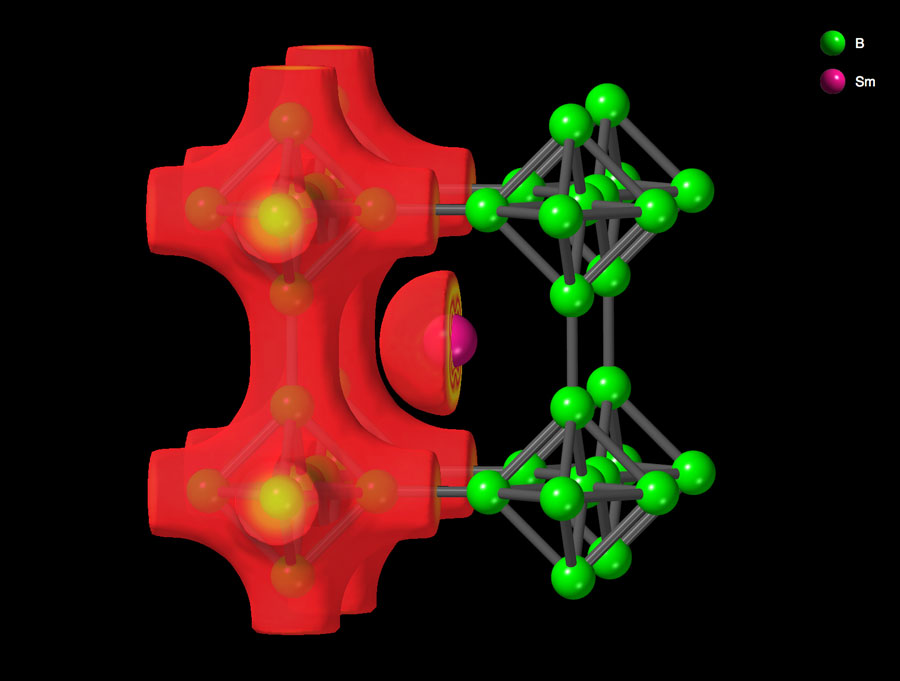
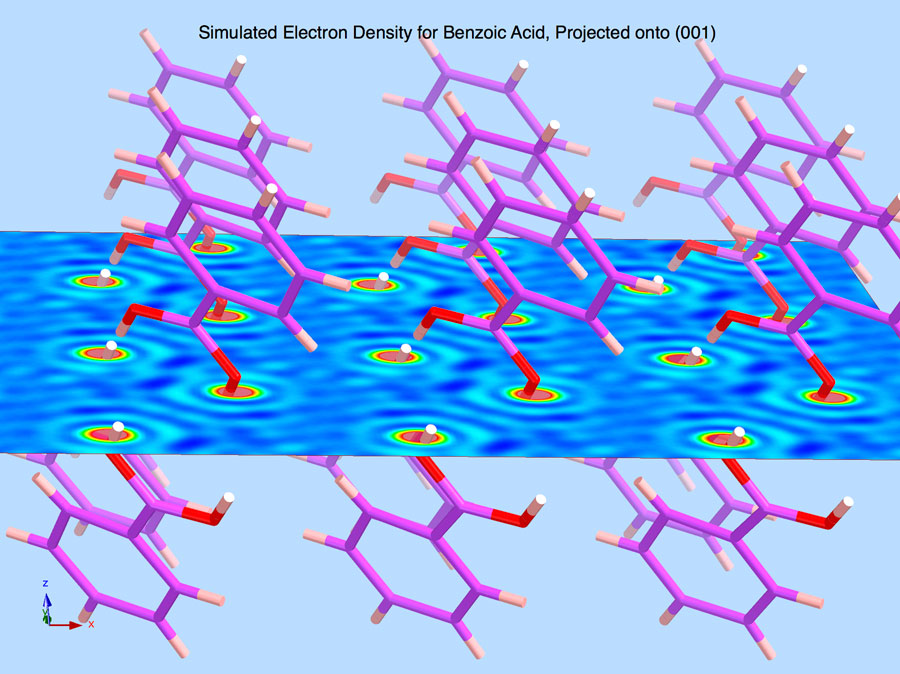
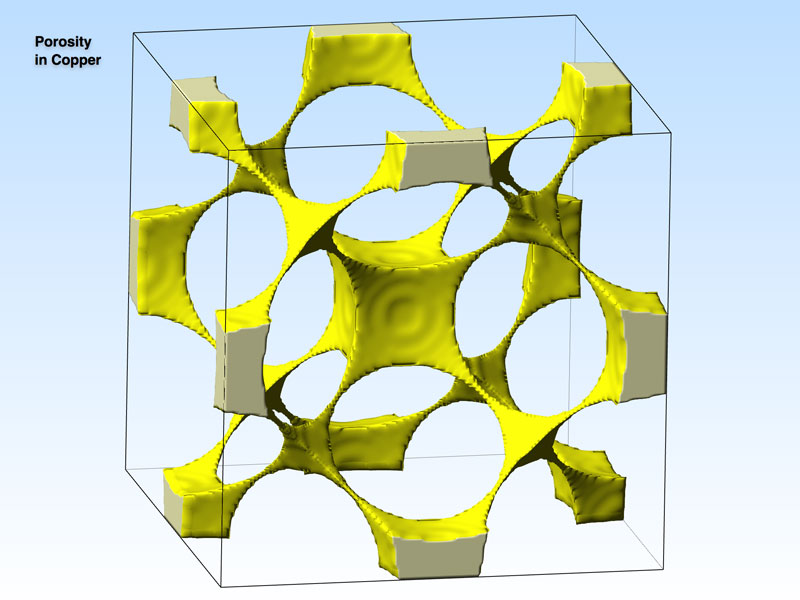
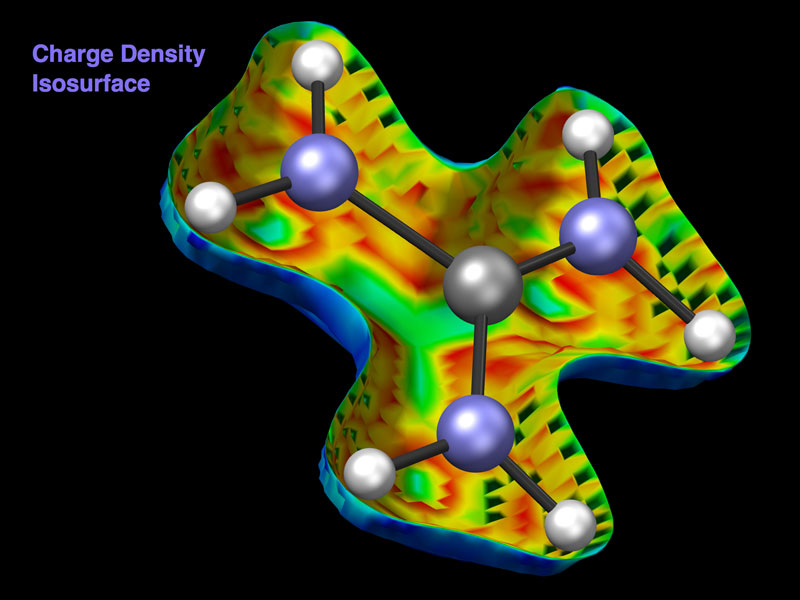
Top Left: Charge density visualized for SmB6. Part of the translucent density overlay has been cut away to reveal the underlying crystal structure. Top Right: Electron density simulated for benzoic acid and projected onto an (001) plane. Bottom Left: Visualization of porosity in the copper structure. Bottom Right: Charge density imported from a Gaussian CUBE file and depicted as a gradient isosurface. (Click to zoom)
- Visualize volumetric data from 3ED, CASTEP, Gaussian CUBE, DEN, GRD, GULP, VASP, Voxel, XSF files
- Visualize porosity as "negative" (void) or "positive" (filled) space.
- Calculate and visualize electron density for any crystal.
- Clamp data display range using range slider.
- Point cloud (size or opacity) display option.
- Visualize multiple lattice planes sections, with transparency.
- Display iso-surfaces or volumes with real-time range control.
- Flatter your experimental data with bicubic interpolation for gorgeous smooth display.
- Customize interior, exterior and truncation colours.
- Choice of colour gradients.
- Work with multiple datasets in the same window.
- Add or subtract datasets.
Build New Crystals & Molecules Fast!
With CrystalMaker you can build any kind of crystal or molecular structure - quickly and easily. Built-in symmetry handling and the elegant spacegroup browser takes the slog out of crystallography, and the program will automatically generate all your bonds and polyhedra Video. Molecule building is even easier: point-and-click to add atoms and bonds. Use the new Relax command to minimize energy and optimize your structure Video.
CrystalMaker provides a wide range of model types, including traditional "ball-and-stick", space-filling, polyhedral, wireframe and thermal ellipsoids. Each model type can be extensively customized, with the option of photo-realistic graphics or simpler, line-art display. CrystalMaker allows continuous plot range settings for millions of atoms, bonds and polyhedra.
Outstanding 3D Graphics
CrystalMaker features industry-leading 3D graphics, for spectacular - and fast - pixel-perfect visualizations with perfect overlap correction and translucency. Enjoy high-resolution "Retina" graphics on the latest Macs or Surface Pro devices. Save publication-quality graphics - with transparency - or generate engaging videos of rotating structures or animations.
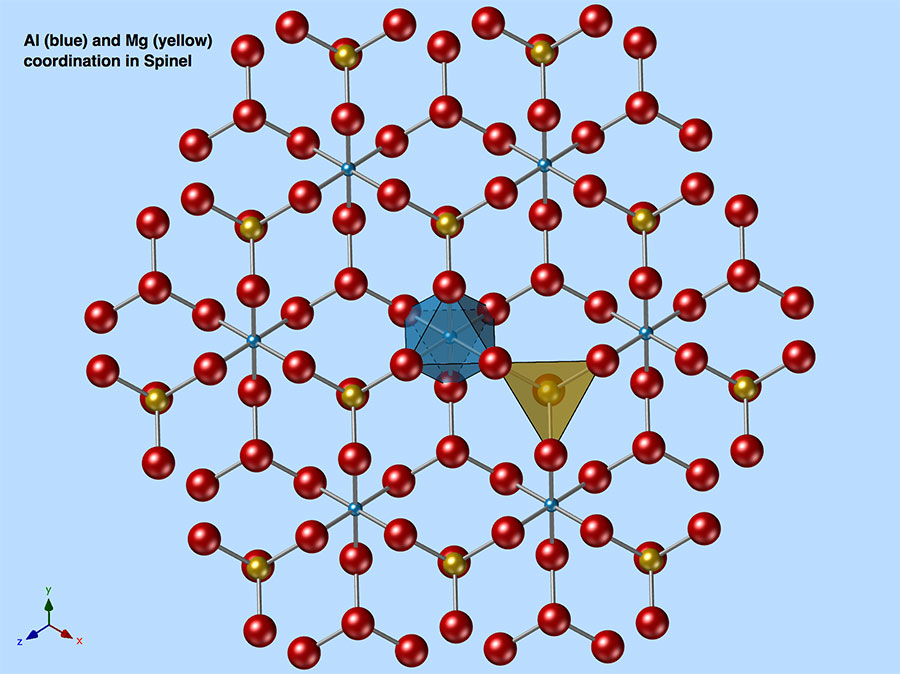

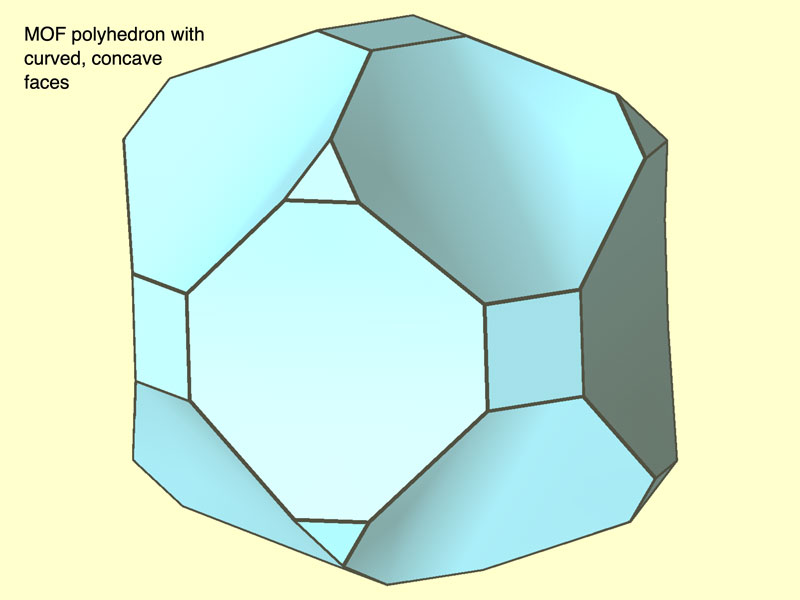
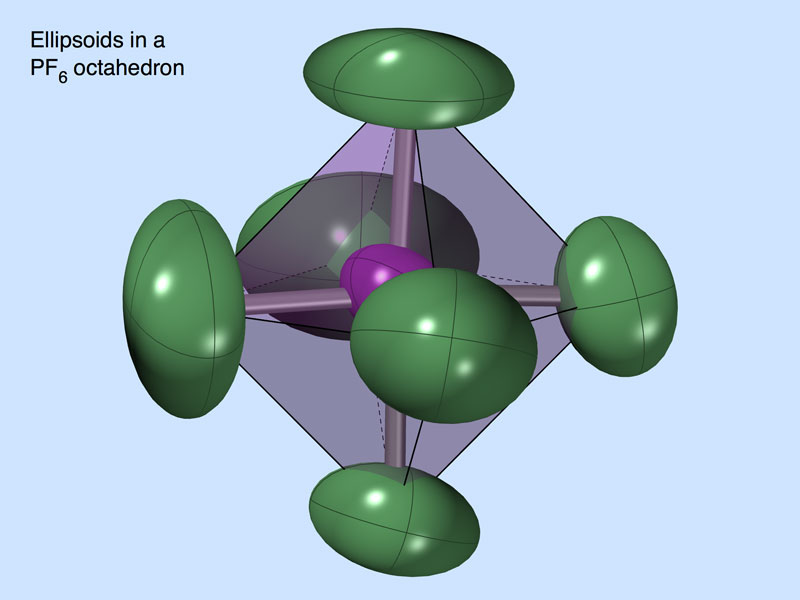
Top Left: Applying different polyhedral styles to different atoms in the same crystal. Top Right: Atom vectors. Bottom Left: Concave polyhedron with curved faces. Bottom Right: Ellipsoids at the corners of a translucent polyhedron. (Click to zoom)
Real-Time Manipulation
Click-and-drag with the mouse, use the keyboard, or toolbar. View parallel to a vector or plane normal. Take advantage of multi-touch rotation and scaling with a trackpad, or simple hand gestures in space using the built-in FaceTime camera (Mac), or an optional Leap Motion Controller (Windows) Video. CrystalMaker for Mac - as a proper native Mac application - sports a dedicated Touch Bar interface for 2016-2022 MacBook Pros: rotate and zoom with dedicated touch dials, direction presets and sliders.




Some of the many Touch Bar interfaces available in CrystalMaker. From top: default layout; rotation dials; structures scrubber; atom picker. These can be seen on 2017-2023 MacBook Pro computers and demonstrate our commitment to genuine native Mac software, working in close partnership with Apple.
Multi-Structure Animation
CrystalMaker is the first program of its kind to go beyond static structures, to let you explore structural behaviour quickly and easily. Just drag-and-drop files into the same window, then rearrange their thumbnails to build your movie timeline. Manipulate and synchronize views, drag-and-drop thumbnails to rearrange them, then click the Play button and visualize the animation. It doesn't stop there: CrystalMaker X lets you rotate and scale animations, change their model types, view directions and model settings. You can also use the Playback Controls to "scrub" through an animation sequence: it's an ideal way to rapidly browse a simulation trajectory. Finally, you can export your animation as a movie - for use on the web or in a presentation Video.

Relaxation of six-membered rings in the leucite structure.
Create Compelling Education Content
CrystalMaker documents can save multiple structures, each with its own graphical thumbnail. Whilst an obvious application is for structural behaviour and animation, you can also save different views of the same structure, different model types, atom ranges, or related structures. Since each structure can have its own notes, this makes an ideal educational tool - a full-interactive slideshow with rotatable 3D models, presented in context. Examples of how to build engaging educational content are included with the program (e.g., "Building Quartz", "Building Spinel").
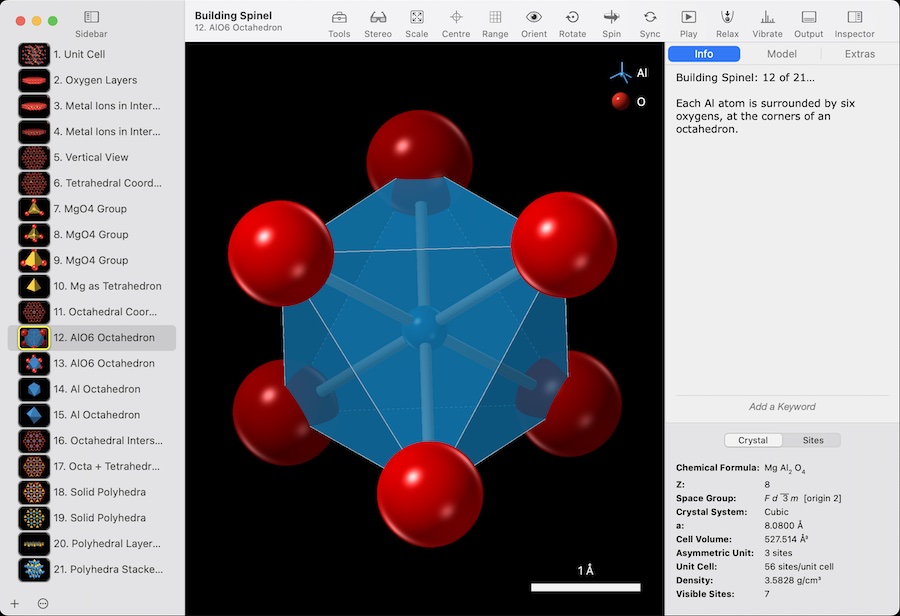
A multi-structure document window showing a list of model structures (in compact, "List View") on the left, with the current model and its notes displayed on the right.
Did you know? You can share your structural models with students and colleagues with a CrystalMaker Software site licence. This low-cost, annual licensing scheme covers your entire site - since you'll have colleagues in other departments who'll also want to use the software. And it covers use of both Mac and Windows versions - plus our sister programs CrystalDiffract and SingleCrystal. This is a great way to engage with a student community, letting them "learn through play" in their own time, and demonstrating genuine value returned. Learn More...
3D Printing & Model Export
CrystalMaker lets you print 3D models of your structures, via the STL 3D file export option (widely supported by most 3D printers). You can also export any structure as a self-contained COLLADA 3D file: ideal for exchange with 3D graphics software. Even better, you can view your CrystalMaker COLLADA files on your iPad! Just drop your files into iBooks Author (a free download from the Mac app store), then publish to your iPad.
Diffraction Support
Diffraction patterns can be simulated for any displayed crystal structure, with just a single menu command - thanks to our CrystalDiffract (powder diffraction) and SingleCrystal (X-ray, neutron and TEM single-crystal diffraction) programs. SingleCrystal can be linked with CrystalMaker, so as you rotate your structure its diffraction pattern rotates, and vice versa Video. A new "Live Powder Diffraction" mode lets you edit your structure in CrystalMaker and see its corresponding powder diffraction pattern update in real time, in CrystalDiffract Video.

The CrystalMaker Office: visualizing a zeolite structure in CrystalMaker 11 (left), with its powder diffraction shown in CrystalDiffract 7 (top right) and an electron diffraction pattern in SingleCrystal 5 (bottom right).
Crystals Included!
CrystalMaker includes CrystalViewer, providing an expertly-curated collection of some 1400 crystal & molecular structures - indexed, annotated, and ready for instant display.
CrystalViewer also includes a wealth of teaching resources, including animated crystal chemistry tours, covering structure types from close-packed metals, through simple ionic compounds, silicates and through to "hybrid materials" such as Metal-Organic Frameworks (MOFs).

Learning crystal chemistry with CrystalViewer's animated teaching libraries.
Cross Platform - Done Properly
CrystalMaker is available in two separate versions, for 64-bit Windows or 64-bit macOS. Mac and Windows versions can read the same documents, and have similar feature sets, making cross-platform working and collaboration easy. Each version is designed, from the ground up, for its respective operating system, offering genuine operating system support and maximum performance - with no compromises.
Most Scientific Software Sucks
Sadly, many scientific programs - especially "free" programs - aren't true Mac or Windows programs at all. Their developers don't have the skills - or can't be bothered - to do a proper job. They choose the lowest-common-denominator: porting the simplest functionality from one operating system to another, using third-party translators such as Qt, wxWidgets or Java...
...The resulting applications can't play to the strengths of your operating system; they miss out on graphics acceleration; they typically have crude, ugly interfaces; and boy, they are slow! Because the software only runs because of crude hacks - working against, rather than with the operating system - they are a compatibility nightmare: just look at Java!
What's more, if the software claims to be "free" (nothing in life is free - chances are you're paying a high price for it in your taxes or your research funding being top-sliced) there will be no effective support, paltry updates - and a massive question mark over its long-term viability.
We do Things Differently
We are professional scientific software developers. We're registered with Apple and Microsoft and use only their developer tools to develop native software for each platform: tuned for optimum performance and usability.
We develop the best software we can, supported by our paying customers. In return we offer free, long-term support with regular updates. No hidden subsidies, no government bailouts. We think this is the only honest way of developing software for the long term.
Case Study: macOS

Mac Universal
We worked closely with colleagues at Apple to fine-tune CrystalMaker X for Mac, visiting the Apple campus to demonstate our software, having our Apple friends test the software - and receiving their advice on new features, including Touch Bar integration.
Because we write native Mac software, we're able to offer better performance and a better user experience. Simple things like:
- Universal Binary: runs natively on Apple Silicon & Intel.
- Works seamlessly on macOS 13 Ventura
- Gorgeous Retina Graphics.
- Multi-touch (rotation & zooming).
- Haptic feedback (feel your structure!).
- Dark Mode.
- Touch Bar interface for MacBook Pro.
- Full-screen mode and Spaces support.
- Document tabs.
- Quick Look previews & Finder thumbnails.
- QuickTime video.
- Apple Help - with search.
- Gatekeeper Friendly: Code-signed, sandboxed, notarized.
You won't see these in other programs - but they all add up to a great user experience that helps justify your choice of the Mac platform (if you're not going to use native Mac software, why go to all the expense of buying a Mac in the first place?!).
Case Study: Windows Surface Pro
We paid particular effort to supporting Microsoft's new range of Surface Pro tablets. This meant adapting the software to work in a "Tablet" mode and devising new code to support multi-touch control.
- Native Windows interface.
- Uses the Microsoft installer.
- Beautiful high-DPI graphics.
- Multi-touch rotation and scaling
- Works with the Leap Motion 3D controller

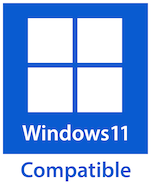
We develop genuine Mac and Windows programs.
Give your Computer the Software it Deserves
If you spend a fair amount of time on your computer, you'll appreciate the difference our no-compromise approach makes. And if you've recently bought a new computer, you'll really see the difference!
First-Class Support
Using CrystalMaker is easy - but to get you up-to-speed as quickly as possible, we include a handy tutorial, designed to familiarize yourself with the essential program features. Online Help provides a quick reference to the interface and capabilities - and for the definitive reference, we include a highly-detailed and profusely-illustrated 160-page User's Guide. This is supplied in Adobe PDF format, for easy searching - and includes page thumbnails for quick browsing.
Last, but not least, we're proud of our first-class technical support, which includes regular incremental software updates, as well as a prompt and personalized response to queries.
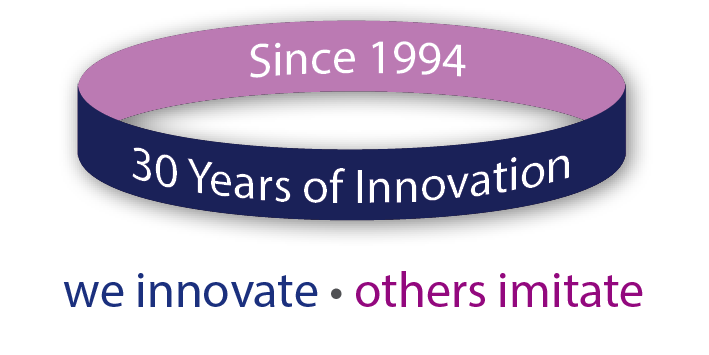
Try it out for yourself: Download CrystalMaker for Mac or Windows today. Plus, learn how our low-cost, flexible site licensing helps empower your research and enthuse your undergraduate students.